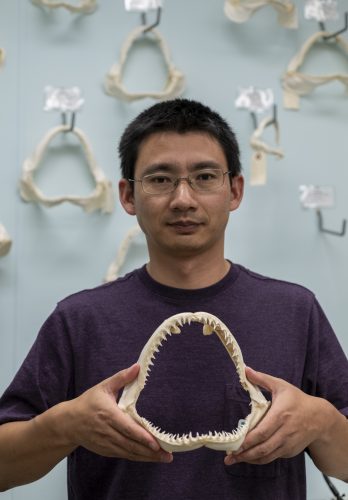Lei Yang is a postdoctoral researcher with the Florida Program for Shark Research.
1. Where are you from?
I was born in Xiangyang, a city in central China.
2. Why did you want to be a scientist when you grew up?
The largest branch of the Changjiang River runs through my hometown. When I was a kid, I like to explore the river bank and catch crabs and fishes along the way with other kids. I also like to make stuff at home back then. I guess these happy experiences eventually took me to what I am doing now.
3. How did you come to study sharks?
I have been working on another group of fishes, the carps and minnows, for my Ph.D. project. In 2012, I met Dr. Naylor during a conference held in Canada. He later offered me an opportunity to join his lab to work on sharks. I only had very little knowledge of sharks back then but I was eager to learn more about these cool fishes. So, I joined the lab a few months later.

4. What are the current projects you are working on?
Currently, I am working together with other members of the lab to build a tree to show the relationships among all known shark species that we are able to get samples. I am also helping other lab mates to study the population genetics and conservation of some sharks. Another part of my job is to identify shark species from dry samples, shark teeth, egg cases, and environmental DNA samples etc. That people from all over the world want identified.
5. Why should people care about your work?
We are doing some solid basic research on sharks based on DNA sequence data from >20,000 tissue samples collected around the world. What we found will not only help people better understand the diversity, evolution, and biogeography of sharks, but also promote the research on other aspects of sharks.
6. What is your favorite shark or shark fact and why?
I would say the Whale shark. It is the largest fish in the world, but it is so peaceful and elegant.